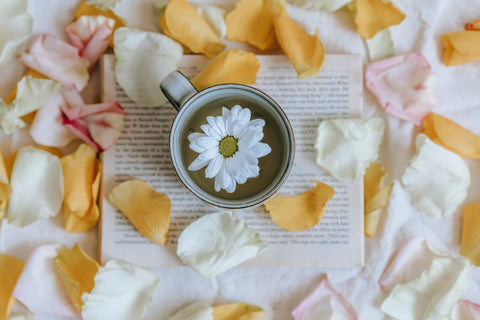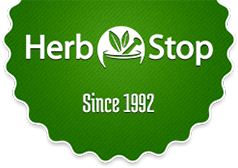The Herb Stop Blog
Loose-Leaf Tea vs. Tea Bags: Why We Only Sell Loose-Leaf Tea

A question we commonly get is, “Why don’t you sell tea bags?”
And we completely understand why this is a common question. After all, tea bags are convenient and neat, and we’re all trying to save time.
However, the benefits of drinking loose-leaf tea versus prepackaged tea in bags are enormous. Keep reading for a close look at the differences between drinking loose-leaf tea and tea bags and how these differences can impact the taste, health benefits, and our planet.
Concerns about Tea Bag Materials
One difference we’d like to note is that some of our clients are concerned about drinking tea in tea bags because they are worried about the tea bags containing microplastics or other undesirable ingredients.
For example, old-style paper tea bags, which have been used for about 80 to 100 years, are made from abaca fibers. However, petro-based nano plastics are blended into the abaca fiber materials to seal the tea bags.
The abaca fibers are also typically bleached. Depending on the company, this bleaching process is performed with chlorine or CO2. If the tea bag is white, it’s almost always bleached with chlorine, another chemical that many want to understandably avoid because even small chlorine exposure can lead to nose, throat, and eye irritation, according to the CDC.
Nylon tea bags are another option. However, they are made with 100% pure plastic, other than the tea inside, which is a concern for many tea drinkers.
In contrast, loose-leaf tea is made with a tea infuser, like our stainless steel 2” Mesh Tea Ball Infuser or our darling Manatea Tea Infuser made from food-grade silicone and a rubber infuser. Many of our customers prefer using a tea infuser because they know what materials are being used to brew their tea, and it’s a more sustainable option!
Improved Flavor
You’ll struggle to find a real tea enthusiast who doesn’t prefer the flavor of loose-leaf tea over tea brewed from a tea bag.
A lot of tea is turned to dust or fannings, which are tiny bits of tea typically found in mass-produced tea bags. Fannings are often the leftovers from producing loose-leaf tea!
Unfortunately, these varieties of tea have less flavor and aroma.
One reason is that mass-produced tea bags are usually filled with tea leaves in one location and must travel a long distance before reaching grocery store shelves. This means the tea is much less fresh.
Mass-produced bagged tea is also blended for a standard taste, so it’s much harder to pick out the delicious nuances between different tea leaves and ingredients than it is when you drink a cup of loose-leaf tea.
You’ll also find that many tea bags give the tea a sharp, astringent taste which many of us find unpleasant. You would be surprised how many people don’t like a specific type of tea until they try its loose-leaf form!
Better Health Benefits
Creating dust or fannings for tea bags exposes the tea to the environment faster because a higher surface area is exposed. If you’re drinking tea for health benefits, the quality of those healthy ingredients is degraded too.
For example, catechins are one of the powerhouse ingredients found in green tea, but they degrade quickly when exposed to the environment. As a result, it’s always best to drink fresher, loose-leaf green tea to enjoy any potential health benefits in its purer form.
Drinking loose-leaf tea provides many more options when picking a tea that suits your taste and caffeine preferences. You’ll also find more loose-leaf teas curated to support different health needs, like a better night’s sleep.
For example, our Deep Sleep Tea alone has lavender, oat straw, chamomile flowers, safflower, and sunflower petals to promote a better night’s sleep. These ingredients are certified organic and combined in the ideal ratio to support a calmer mind and body, and may even increase oxygen uptake in your system!
While tea bags may share similar claims for promoting a better night’s sleep, you’ll be pressed to find a tea bag with ingredients that are as unique, high-quality, and tailored to your needs. Even if you find a multi-faceted tea in a tea bag, the process of creating the tea and how long it’s been sitting on the shelf has likely reduced many of its potential health benefits.
Loose Leaf Tea is a More Sustainable Option
Many types of tea bags are not fully compostable or biodegradable.
Old-style paper tea bags are made from around 98% abaca fibers and 2% petro-based nano plastics. Unfortunately, the 2% petro-based nano plastics make the bag difficult to compost because they aren’t biodegradable.
According to several articles, the ocean is also filled with an unprecedented amount of over 170 trillion plastic particles, like the petro-based nano plastics used for traditional paper tea bags.
One study even found that if all these plastic particles were gathered, the mass would weigh about 2.3 million tons. These plastic particles are difficult to remove from the ocean and can leach toxic chemicals into the water. Marine life can also become entangled in plastics or mistake them for food.
Other tea bags, like nylon pyramid-shaped tea bags, are not compostable or biodegradable in any way. Unfortunately, those nylon tag bags will remain in landfills for centuries.
While some companies are making advances in creating more sustainable and completely compostable tea bags, using a tea infuser is arguably more sustainable as you’re not adding anything to landfills. High-quality tea infusers like the ones we sell at Herb Stop are designed to be food safe and durable so that you can get many years out of just one tea infuser.
We hope this article gave you some food for thought about the benefits of loose-leaf tea and explained why we are so passionate about loose-leaf tea ourselves. There are just too many reasons to love loose-leaf tea!
Well Wishes,
Herbalists Natalie & Leilah
